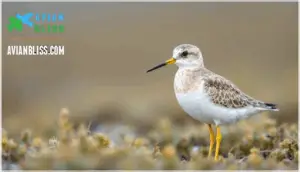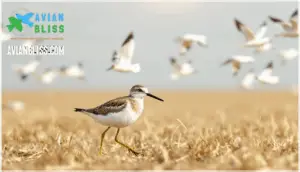This site is supported by our readers. We may earn a commission, at no cost to you, if you purchase through links.
 A buff-colored ghost slipping through September prairies—that’s your first glimpse of a Buff-breasted Sandpiper, one of North America’s most enigmatic shorebirds. With fewer than 56,000 individuals left worldwide, this Near Threatened species travels from Arctic breeding grounds to South American grasslands each year, stopping briefly in agricultural fields where lucky birders can spot their distinctive buffy plumage and theatrical courtship displays.
A buff-colored ghost slipping through September prairies—that’s your first glimpse of a Buff-breasted Sandpiper, one of North America’s most enigmatic shorebirds. With fewer than 56,000 individuals left worldwide, this Near Threatened species travels from Arctic breeding grounds to South American grasslands each year, stopping briefly in agricultural fields where lucky birders can spot their distinctive buffy plumage and theatrical courtship displays.
Unlike most shorebirds that hug coastlines, these sandpipers prefer dry, short-grass habitats, making them outliers in their own family. Understanding their unique identification features, specialized habitat needs, and conservation challenges can help you appreciate—and protect—these notable long-distance migrants.
Table Of Contents
- Key Takeaways
- Buff-Breasted Sandpiper Identification
- Habitat and Geographic Range
- Unique Behaviors and Life Cycle
- Conservation Status and Threats
- How to Support Buff-Breasted Sandpipers
- Frequently Asked Questions (FAQs)
- Why is the buff-breasted sandpiper important?
- How fast can a buff-breasted sandpiper fly?
- What predators do buff-breasted sandpipers face?
- How long do buff-breasted sandpipers typically live?
- Do buff-breasted sandpipers migrate in flocks?
- Can buff-breasted sandpipers swim?
- What is the lifespan of a Buff-breasted Sandpiper?
- How do Buff-breasted Sandpipers communicate with each other?
- What predators threaten Buff-breasted Sandpipers most?
- How has pesticide use affected their populations specifically?
- Conclusion
Key Takeaways
- Buff-breasted Sandpipers have plummeted from millions to roughly 56,000 individuals today, making them Near Threatened due to overhunting in the 1920s and ongoing habitat loss across their Arctic breeding grounds, migration corridors, and South American wintering sites.
- These shorebirds break the mold by preferring dry grasslands over wetlands and perform theatrical lek displays where males flash brilliant white underwings to compete for mates—a unique mating system among North American shorebirds where females do all the parenting solo.
- Native grasslands have shrunk 80% since 1900, with 75% of their South American Pampas wintering habitat converted to soybean farms and critical stopover areas losing 70% of grasslands, forcing birds into fragmented, pesticide-laden croplands that threaten their survival.
- You can directly support these travelers by protecting grassland habitats through native plantings, reporting sightings on eBird to aid conservation tracking, supporting organizations like Barba Azul Reserve, and reducing pesticide use on your property during their migration seasons.
Buff-Breasted Sandpiper Identification
Spotting a Buff-breasted Sandpiper takes a practiced eye, but once you know what to look for, you’ll recognize this delicate shorebird among its cousins. The key is picking up on a few distinctive features that set it apart from other small sandpipers—and we’re going to walk you through exactly what those are.
Think of this guide as your field checklist: the physical traits, plumage details, and field marks that’ll help you nail a confident ID.
Physical Description and Size
Picturing a pint-sized shorebird built for open grasslands rather than mudflats, you’re looking at the Buff-breasted Sandpiper—a compact marvel of adaptation. These delicate birds measure just 18–20 cm (7.1–7.9 in) and weigh 46–78 g depending on season and sex, making them lighter than many backyard sparrows. Despite their small stature, they pack distinctive proportions that set them apart:
- Long yellow legs paired with a proportionally short bill create their signature silhouette
- Rounded head and large dark eye give them an almost quizzical expression unique among sandpipers
- Slender, elongated body with wingtips extending nearly to the tail tip
Their relative size places them between the diminutive Semipalmated Sandpiper and the heftier Red Knot, yet their shape—particularly that rounded head and compact build—gives them an oddly pigeon-like appearance.
The species is currently listed as having Near Threatened status. Weight variation is significant: males on Alaskan breeding grounds usually weigh 57–78 g, while northbound migrants can reach 80–117 g as they fuel up for long flights. That size and shape flexibility is key to their survival across diverse habitats spanning tundra to prairie.
Plumage and Coloration
Now that you understand the Buff-breasted Sandpiper’s compact build, look closer at what makes its plumage stand out. This species wears a distinctive buffy wash across its face and underparts—noticeably paler than most sandpipers you’ll encounter. The back displays fine, dark feather centers edged in buff, creating precise scaly patterns, while the crown carries delicate black streaks.
In flight, you’ll spot a bright white underwing with a dark comma mark at the carpal joint, a unique pattern among North American shorebirds. Juveniles show broader buff fringes and rounder spotting, giving them a scaly look adults lack.
Color variations between seasons remain minimal, though breeding plumage intensifies buff tones, and distinguishing this species from similar Pectoral or Upland Sandpipers relies on that overall paleness and yellow-ochre legs. These birds breed in High Arctic regions.
Key Field Marks for Birdwatchers
Now that you’ve grasped the plumage details, here’s what to actually look for in the field. The Buff-breasted Sandpiper’s pale buff underparts and yellow legs immediately set it apart from darker sandpipers, while its clockwork-like head-bobbing motion reveals actions few waders share. Watch for that bright white underwing with the dark carpal comma during flight—a dead giveaway among similar species.
- Size and shape: Compact body (18–23 cm) with a short black bill and pigeon-like round head; shorter legs than Ruffs or Pectoral Sandpipers
- Behavioral cues: Constant ground motion, frequent head-bobbing, and preference for dry grasslands rather than wetlands distinguish it from look-alikes
- Flight patterns: Shallow, steady wingbeats reveal bright white underwings with that distinctive dark comma mark at the carpal joint
Habitat and Geographic Range
The Buff-breasted Sandpiper’s journey across North America is striking—it breeds in the remote High Arctic and travels thousands of miles through diverse landscapes to reach its wintering grounds.
Where exactly does this little shorebird show up, and what draws it to specific habitats along the way? Let’s map out the breeding grounds, migration corridors, and stopover sites that make this species’ annual cycle possible.
Breeding Grounds in The High Arctic
The High Arctic isn’t an easy place to call home, but that’s exactly where Buff-breasted Sandpipers head to breed each summer. These shorebirds nest in Arctic tundra ecosystems, stretching from Alaska’s Point Barrow through Canada’s Northwest Territories and Nunavut, where males perform lek displays on elevated ridges.
Breeding grounds feature sedge meadows and dwarf-shrub cover, though habitat pressures from climate change and industrial development now threaten clutch survival across these remote nesting areas.
Migration Routes Across North America
Each spring and fall migration, Buff-breasted Sandpipers follow the Midcontinental Flyway through central North America—a migratory route spanning over 30,000 km annually. You’ll find these birds passing through the Great Plains, stopping at shortgrass prairies and agricultural fields from North Dakota to Texas before crossing the Gulf of Mexico.
Spring returns concentrate through this central corridor, while fall routes spread wider as juveniles explore coastal paths, demonstrating striking flyway ecology shaped by stopover habitats and conservation efforts against migration threats.
Wintering and Stopover Sites
After crossing thousands of kilometers, Buff-breasted Sandpipers settle into their South American sites—coastal grasslands in Brazil, Uruguay, and Argentina host the bulk of wintering birds.
North American sites like Nebraska’s Rainwater Basin serve as important stopovers during migration, with birds resting just 24–48 hours before continuing their journey. These stopover sites demand specific ecological requirements: short-grass habitats under 10 cm tall where you’ll spot foraging flocks.
Habitat degradation through dredging and land conversion has slashed suitable wintering areas by 65% in some locations, threatening stopover durations and overall survival.
Unique Behaviors and Life Cycle
The Buff-breasted Sandpiper doesn’t just stand out for its looks—its actions are equally fascinating. From theatrical courtship rituals on Arctic breeding grounds to its unusual preference for dry grasslands over wetlands, this species breaks the mold in fascinating ways.
Let’s explore the key stages of its life cycle and the unique habits that make it such an interesting bird to observe.
Mating Displays and Lekking
During the Arctic breeding season, male Buff-breasted Sandpipers put on one of the most theatrical performances you’ll witness on the tundra—a lek mating system unique among North American shorebirds. About 75% of males gather at display grounds called leks, where they compete for female attention through elaborate courtship rituals:
- Males tilt their bills skyward, puff their chests, and raise their wings to flash silvery-white underwings
- Leks typically host 2–3 males, though up to 20 have gathered at prime lek sites
- These display grounds are ephemeral—69% last just one breeding season
Lek site selection matters: males prefer dry tundra ridges and gravel flats where visibility’s best. Female mate choice drives this polygamous species’ dynamics, yet unlike other lekking birds, multiple males achieve Arctic breeding success rather than one dominant performer. Some males practice nomadism benefits, traveling between leks to find fertile females.
Remarkably, about 25% of males skip leks entirely, displaying solo—and females sometimes choose these independent performers. After mating, females do all the parenting alone while males continue their displays, hoping to mate again.
Diet and Foraging Techniques
If you’ve ever watched shorebirds speed-walk across mudflats, you’d expect the Buff-breasted Sandpiper to follow suit—but this species breaks the mold. Unlike its wetland-loving cousins, you’ll find these birds foraging in dry, short-grass habitats where insect prey dominate their diet. They use a distinctive "stop-run-peck" feeding pattern, visually scanning for beetles, ants, flies, and spiders rather than probing mud. Their short bills—perfect feeding adaptations for surface pickups—suit their terrestrial niche.
During migration, stopover ecology reveals fascinating dietary variation: over 60% of daylight hours are spent foraging in freshly planted croplands under 7 cm tall, where invertebrates are abundant. Dietary habits shift seasonally, with Arctic breeders consuming tundra insects while wintering flocks in South America feast on arthropods in grazed grasslands.
Nesting and Parental Care
Once breeding begins, nesting success hinges almost entirely on the female’s solo efforts—males stick to lekking sites rather than helping with eggs or young. Here’s how breeding unfolds:
- Nest site selection occurs on dry tundra slopes with vegetation under 10 cm, often within 100 meters of freshwater
- Egg incubation lasts 22–23 days for clutches of 3–4 buff-colored eggs deposited in mid-June
- Chick development progresses rapidly—precocial young leave the nest within 12 hours and fledge by day 18–20
- Environmental influences shape outcomes dramatically: stable temperatures yield 61% nest success, while late storms drop survival below 40%
Parental roles remain entirely uniparental, with females brooding chicks up to 40% of daylight during cold snaps.
Conservation Status and Threats
The Buff-breasted Sandpiper isn’t doing well these days, and you should know why. Once numbering in the millions, this delicate shorebird now faces serious threats that have landed it on the Near Threatened list.
Let’s look at what’s pushing this species toward the edge and what it means for its future.
Population Trends and Estimates
How well is the Buff-breasted Sandpiper’s numbers known? The global population estimate sits at roughly 56,000 individuals—though that range stretches from 35,000 to 78,000, revealing real monitoring challenges.
Historical declines were devastating: overhunting nearly wiped them out by the 1920s. Today’s population studies show regional variations and potential ongoing population declines, earning this species its Near Threatened IUCN status.
Estimate accuracy remains tricky, complicating conservation goals and affecting our conservation status assessments.
Habitat Loss and Fragmentation
The numbers tell one story, but habitat loss writes another—and it’s happening fast. Across the Buffbreasted Sandpiper’s entire range, native grasslands have shrunk by roughly 80% since 1900, with breeding tundra, migration corridors, and wintering grounds all under pressure from agriculture, development, and energy projects.
Native grasslands across the Buff-breasted Sandpiper’s range have shrunk by roughly 80% since 1900, pressuring breeding tundra, migration corridors, and wintering grounds through agriculture, development, and energy projects
Here’s what habitat fragmentation looks like on the ground:
- Tundra degradation: Shrub expansion now affects over 70% of Arctic breeding sites, while infrastructure near oil fields has cut nesting density by 30%
- Prairie habitat loss: Less than 5% of untouched prairie remains in the Great Plains, forcing birds into modified croplands
- Grassland conversion: The South American Pampas—their primary wintering grounds—has lost 75% of native habitat to soybean farming since 1970
- Migration corridor collapse: Major stopover areas in Texas and Nebraska have shed 70% of native grasslands, leaving birds dependent on sod farms and airports
- Fragmented landscapes: Large contiguous stopover sites dropped by 40% between 1980 and 2020, isolating populations and reducing food availability
You can see why conservation efforts face such uphill battles.
Climate Change and Other Risks
Beyond habitat loss, climate change impacts on birds now compound every survival challenge. Arctic habitat loss through shrub expansion threatens to eliminate 50% of breeding grounds by 2070, while rising sea levels flood coastal nesting sites and South American wintering areas.
Temperature phenology mismatch—when chicks hatch before insects emerge—can slash survival by 30%. Chemical pesticide exposure in croplands kills migrating birds outright, and industrial infrastructure impact from wind farms and oil extraction fragments what’s left.
Climate threats aren’t distant—they’re reshaping conservation priorities right now.
How to Support Buff-Breasted Sandpipers
You can make a real difference for these special shorebirds, even if you’ve never spotted one in the wild. Whether you support conservation groups, create grassland-friendly spaces, or adjust your daily habits, every action counts.
Let’s explore three practical ways you can help protect Buff-breasted Sandpipers and their disappearing habitats.
Conservation Initiatives and Research
Through thorough tracking data and policy collaboration, the conservation mission for Buff-breasted Sandpipers spans continents. Population monitoring programs like PRISM use satellite technology to map migration routes, while habitat restoration efforts in the Rainwater Basin protect critical stopover sites. Climate mitigation strategies address breeding ground changes, and community involvement connects farmers with Buff-breasted Sandpiper conservation goals across the Americas.
- PRISM surveys reveal breeding densities you wouldn’t expect in Arctic Canada
- Nine key sites in the Western Hemisphere network safeguard their epic journey
- Flyway-scale partnerships unite nations from Alaska to Argentina in shared purpose
Creating Bird-Friendly Habitats
You can turn your own property into a haven for Buff-breasted Sandpipers by focusing on grassland restoration with native seed mixes, wetland management that includes shallow seasonal flooding, and sustainable agriculture practices that limit pesticides.
Threat mitigation through access control—like fencing cattle away from sensitive areas—directly lessens habitat loss while creating bird-friendly practices that benefit these striking travelers during migration.
Ways Individuals Can Help
You can make a real difference through citizen science by reporting sightings on eBird or iNaturalist—data that directly aids conservation missions tracking migration patterns.
Support habitat restoration efforts in places like Bolivia’s Barba Azul Reserve, join advocacy campaigns highlighting habitat loss, and reduce threats by avoiding pesticide use and backing BirdFriendly practices.
Community engagement through donations, volunteering, or spreading awareness helps counter the pressures these sandpipers face on their epic journeys.
Frequently Asked Questions (FAQs)
Why is the buff-breasted sandpiper important?
Imagine if a tiny bird held secrets about entire ecosystems. The Buff-breasted Sandpiper does exactly that—serving as an indicator species revealing habitat health across continents.
Your understanding of this shorebird matters because it connects you to climate change impacts, genetic diversity within migratory populations, and conservation urgency spanning breeding grounds to wintering sites.
How fast can a buff-breasted sandpiper fly?
Buff-breasted Sandpipers achieve flight speeds around 30–40 mph during migration, though precise measurements remain limited. Their wing morphology—relatively short, pointed wings—fosters efficient energy expenditure across migratory routes.
Environmental factors like tailwinds greatly boost migration speeds, allowing these shorebirds to cover vast distances during seasonal movements.
What predators do buff-breasted sandpipers face?
Avian predators hunt buff-breasted sandpipers relentlessly—raptors like Peregrine Falcons and Merlins strike during migration. On breeding grounds, Arctic foxes and jaegers devastate nests, threatening chick survival.
Your sandpipers employ alarm calls and predator avoidance tactics, fleeing to grasslands where habitat offers concealment from these deadly threats.
How long do buff-breasted sandpipers typically live?
Lifespan data remains limited, though mortality causes—including migration hazards and habitat loss—shape average longevity. Average longevity isn’t precisely documented; young birds achieve flight at 16-20 days.
Data collection efforts through ringing programs continue expanding our understanding of buff-breasted sandpiper conduct and maximum age records for this species.
Do buff-breasted sandpipers migrate in flocks?
Unlike solitary travelers, shorebirds don’t fly solo during migration—they’re team players. Buff-breasted sandpipers migrate in mixed flocks with other shorebird species, gaining safety and efficiency through group movement.
This flock composition provides directional assistance and predator protection during their long journey across North America’s migration corridors.
Can buff-breasted sandpipers swim?
These shorebirds aren’t built for swimming—they’re designed for dry land. Unlike most sandpipers, buff-breasted sandpipers avoid wetlands entirely, relying on their long legs for foraging in grasslands.
Their lightweight bodies and evolutionary pressures favor ground-dwelling over water interaction, making swimming ability minimal.
What is the lifespan of a Buff-breasted Sandpiper?
Don’t get caught off your toes on this one—lifespan data for Buff-breasted Sandpipers remains scarce. Average longevity factors include predation, disease, and migration hazards affecting wild birds. Maximum age records depend on ringing studies, which rarely document these traveling shorebirds.
Migration habits and Buff-breasted Sandpiper habitat loss compounds mortality causes during their marathon journeys. Aging process and conservation efforts continue tracking population dynamics.
How do Buff-breasted Sandpipers communicate with each other?
These birds communicate through vocalizations—sharp alarm calls alert flockmates to danger—and visual signals during mating displays. Males perform elaborate lek displays, weaving through the air with raised wings and puffed breasts to attract females.
Tactile communication strengthens pair bonds, while chicks respond to parental calls, enabling coordination within family groups and colonies.
What predators threaten Buff-breasted Sandpipers most?
Predators targeting these small sandpipers include Arctic foxes, jaegers, and gulls that raid nests during the breeding season.
During migration and wintering, raptors like Merlins and Peregrines hunt adults, while nest predation remains a critical chick survival threat across Arctic breeding grounds.
How has pesticide use affected their populations specifically?
Pesticide bioaccumulation devastates buff-breasted sandpipers during migration. Agricultural chemicals accumulate in invertebrates they consume, causing sublethal effects like weakened reproduction and impaired immune function.
Migratory exposure across croplands compounds these impacts, driving population decline alongside habitat loss.
Conclusion
Picture a birder spotting a buff-breasted sandpiper in an autumn prairie—a moment that captures why these travelers matter. From Arctic tundra to South American grasslands, this striking species completes an epic migration that few of us witness.
Yet habitat loss and climate shifts threaten their journey. By protecting the grasslands they depend on and supporting conservation research, you’ll help guarantee these buff-colored wanderers continue their ancient routes for generations to come.
- https://www.registrelep-sararegistry.gc.ca/virtual_sara/files/cosewic/sr_becasseau_roussatre_buffbreasted_sandpiper_1012_e.pdf
- https://bioone.org/journals/the-wilson-journal-of-ornithology/volume-136/issue-4/23-00044/Impact-of-habitat-change-on-abundance-of-Buff-breasted-Sandpiper/10.1676/23-00044.full
- https://abcbirds.org/bird/buff-breasted-sandpiper/
- https://macaulaylibrary.org/photo/27237751
- http://www.kaufmanfieldguides.com/










